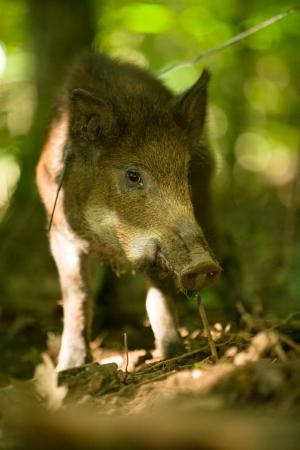 The Missouri Department of Conservation (MDC) is working with public and private conservation partners through the Missouri Feral Hog Partnership to eliminate feral hogs from Missouri. Agencies in the partnership are helping landowners remove hogs from their properties through trapping, and some landowners are attempting to prevent their return through fencing.
The Missouri Department of Conservation (MDC) is working with public and private conservation partners through the Missouri Feral Hog Partnership to eliminate feral hogs from Missouri. Agencies in the partnership are helping landowners remove hogs from their properties through trapping, and some landowners are attempting to prevent their return through fencing.
Feral hogs are highly destructive and prolific pests that eat nearly anything, including many species of native wildlife. They also compete with native wildlife by eating acorns, a major fall food source for deer, turkey, and black bear. Their rooting and wallowing destroy landscapes and pollute ponds, streams, and other waters. Damage caused by hogs has been estimated at nearly $1.5 billion per year in the United States.
MDC and other state and federal agencies are helping landowners with feral hog removal from private properties. Once the hogs are removed, some landowners are using fencing to discourage their return. However, landowners should be aware of potential impacts different fencing types may have on wildlife.
Linda Tanner, a landowner in Reynolds County, took a proactive approach to keeping feral hogs off her land. She and her family trapped 39 hogs on their property and then decided to replace their field fencing with cattle panels to discourage hogs from returning.
“We thought we were being smart to choose cattle panels, as they are taller, sturdier, and longer lasting than our field fencing,” Tanner said.
However, Tanner and her family soon noticed there were dents at the top of the panels, presumably from deer jumping over the fence. They then observed a deer on their property with a leg injury, which confirmed their suspicions. Tanner said she wanted to share her story with MDC in an effort to warn others of the damage improper fencing may cause wildlife.
Mark McLain, MDC’s feral hog elimination team leader, has a few pointers for fencing to help keep out feral hogs.
“Fencing is not a silver bullet,” McLain said. “Hogs can get over, under, or tear through many types of fencing.”
For landowners who want to try fencing as a possible deterrent to feral hogs, McLain recommends electric fencing with three-to-four-strand electric wire set very hot (at least 16 joules).
Another option is woven wire fencing with barbed wire on the bottom to discourage rooting.
“Well maintained fences can sometimes keep hogs out of a crop field or pasture for a short time, but are not a perfect tool to exclude them from your property,” McLain cautioned. “A combination of trapping hogs and fencing sensitive areas works better than just fencing alone.”
McLain said other tools in eliminating feral hogs are landowner-reported sightings and trapping of whole groups of hogs, called sounders. He also asks that people report the release of feral hogs to MDC. Releasing feral hogs is illegal in Missouri. To report feral hog sightings or damage, or to learn more, go online to mdc.mo.gov/feralhog.
